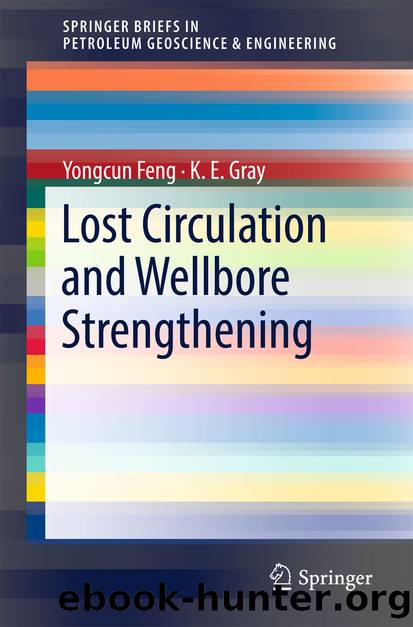Lost Circulation and Wellbore Strengthening by Yongcun Feng & K. E. Gray

Author:Yongcun Feng & K. E. Gray
Language: eng
Format: epub
Publisher: Springer International Publishing, Cham
Fig. 3.13Fracture mouth aperture versus time during the wellbore ballooning event
Fig. 3.14Fluid loss/gain rate versus time during the wellbore ballooning event
Figure 3.12 indicates that the downhole pressure decreases after the initiation of the natural fracture. At the early time of fracture propagation, downhole pressure fluctuations are observed. This downhole pressure behavior is a part of the solution of the simulation, which is quite different from existing models that assume a constant downhole pressure (as an input) during mud loss. The fracture extends to the end of the natural fracture at about 20 s. After that, the downhole pressure, fracture width, and mud loss rate reach relatively constant values with continuing mud circulation. At this period, the mud loss rate is dominated by fluid leak off into formation, rather than by fracture growth.
With pumps stopped, the downhole pressure drops almost immediately to the hydrostatic pressure of 12 MPa. As a result, the fracture aperture decreases to zero, but at a rate slower than the decrease of downhole pressure. With fracture closing, fluid flows out of the wellbore with a gradually decreased rate as shown in Fig. 3.14.
Figure 3.15 illustrates the cumulative fluid volume lost into the formation with time during the circulation and pump-off periods, which is the time integral of the flow rate in Fig. 3.14. The total amount of mud lost into the formation during drilling period is about 0.025 m3, while the final fluid loss at the end of pump-off period is 0.015 m3, indicating a fluid gain of 0.01 m3 after the stop of drilling. The fluid volume that does not return during pump-off period is the part of fluid filtration into the formation. The results demonstrate that the proposed model can simulate the entire process of a borehole ballooning event.
Fig. 3.15Cumulative fluid loss versus time during the wellbore ballooning event
Download
This site does not store any files on its server. We only index and link to content provided by other sites. Please contact the content providers to delete copyright contents if any and email us, we'll remove relevant links or contents immediately.
| Alternative & Renewable | Drilling Procedures |
| Electric | Fossil Fuels |
| Mining | Nuclear |
| Power Systems |
Whiskies Galore by Ian Buxton(40332)
Introduction to Aircraft Design (Cambridge Aerospace Series) by John P. Fielding(32338)
Small Unmanned Fixed-wing Aircraft Design by Andrew J. Keane Andras Sobester James P. Scanlan & András Sóbester & James P. Scanlan(32141)
Craft Beer for the Homebrewer by Michael Agnew(17447)
Turbulence by E. J. Noyes(7039)
The Complete Stick Figure Physics Tutorials by Allen Sarah(6638)
Kaplan MCAT General Chemistry Review by Kaplan(6054)
The Thirst by Nesbo Jo(5786)
Bad Blood by John Carreyrou(5769)
Learning SQL by Alan Beaulieu(5412)
Weapons of Math Destruction by Cathy O'Neil(5037)
Man-made Catastrophes and Risk Information Concealment by Dmitry Chernov & Didier Sornette(4736)
iGen by Jean M. Twenge(4702)
Digital Minimalism by Cal Newport;(4543)
Life 3.0: Being Human in the Age of Artificial Intelligence by Tegmark Max(4508)
Audition by Ryu Murakami(4099)
1,001 ASVAB Practice Questions For Dummies by Powers Rod(4039)
Electronic Devices & Circuits by Jacob Millman & Christos C. Halkias(4029)
Pale Blue Dot by Carl Sagan(4001)
